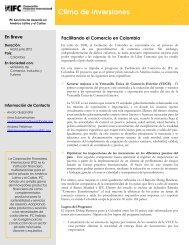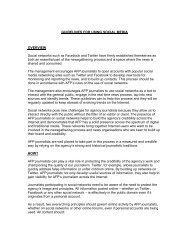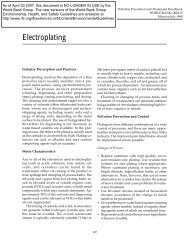A Self-Assessment Guide for Health Care Organizations - IFC
A Self-Assessment Guide for Health Care Organizations - IFC
A Self-Assessment Guide for Health Care Organizations - IFC
Create successful ePaper yourself
Turn your PDF publications into a flip-book with our unique Google optimized e-Paper software.
Standard PS.3 [High alert medications]<br />
The organization develops an approach to improve the safety of high-alert medications.<br />
Intent of PS.3<br />
When medications are part of a patient treatment plan, appropriate management is critical to ensuring patient safety. A frequently cited<br />
medication safety issue is the unintentional administration of concentrated electrolytes (e.g. potassium chloride [2mEq/ml or more<br />
concentrated], potassium phosphate, sodium chloride [0.9% or more concentrated], and magnesium sulfate [50% or more concentrated]).<br />
This error can occur when a staff member has not been properly oriented to the patient care unit, when contract nurses are used and not<br />
properly oriented, or during emergencies. The most effective means to reduce or eliminate this occurrence is to remove the concentrated<br />
electrolytes from the patient care unit to the pharmacy. The organization collaboratively develops a policy and/or procedure that prevents the<br />
location of concentrated electrolytes in patient care areas where misadministration can occur. The policy and/or procedure specifies any areas<br />
where concentrated electrolytes are clinically necessary (such as the emergency department or operating theater); how they are clearly labeled;<br />
and how they are stored in those areas in a manner that restricts access to prevent inadvertent administration.<br />
Measurable Element Look <strong>for</strong> Score Observations<br />
What is required<br />
1) A collaborative process<br />
is used to develop policies<br />
and/or procedures that<br />
address the location,<br />
labeling, and storage of<br />
concentrated electrolytes.<br />
2) Concentrated<br />
electrolytes are not present<br />
in patient care units unless<br />
clinically necessary. Actions<br />
are taken to prevent<br />
inadvertent administration<br />
in those areas where<br />
permitted by policy.<br />
How is this element<br />
assessed<br />
Physicians, nurses and other health<br />
care workers work together to<br />
write and implement policies and<br />
procedures to deal with<br />
concentrated electrolytes. Review<br />
minutes of meetings and talk with<br />
staff members regarding their<br />
involvement.<br />
Make observations during safety<br />
rounds to ensure that concentrated<br />
electrolytes are not kept on the<br />
units, except where policy permits.<br />
In these permitted areas (e.g.<br />
emergency department, ICU) check<br />
that they are properly stored and<br />
labeled.<br />
0 5 10 Why did you give this score<br />
........................................................<br />
........................................................<br />
........................................................<br />
........................................................<br />
........................................................<br />
........................................................<br />
........................................................<br />
........................................................<br />
58 <strong>IFC</strong> <strong>Self</strong>-<strong>Assessment</strong> <strong>Guide</strong> <strong>for</strong> <strong>Health</strong> <strong>Care</strong> <strong>Organizations</strong>














![Print a two-page fact sheet on this project [PDF] - IFC](https://img.yumpu.com/43449799/1/190x245/print-a-two-page-fact-sheet-on-this-project-pdf-ifc.jpg?quality=85)


